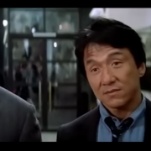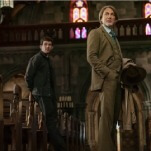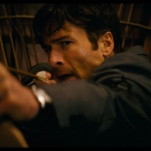Blending supernatural hokum with real horrors of U.S. history—namely, the MKUltra experiments performed by the CIA in the 1950s—Banshee Chapter superficially resembles some lost episode of The X-Files. Consider the evidence: There are terrifying abductions, a government conspiracy, a monster of the week, and several scenes of characters shining flashlights down the long and darkened hallways of abandoned research facilities. The plot, too, is vintage Chris Carter—a mystery involving everything from mind-control serums to numbers stations to alternate dimensions. What’s missing, beyond the sexually charged banter of two mismatched FBI agents, is conceptual consistency. Somehow less cinematic than its small-screen ancestor, Banshee Chapter can’t seem to decide if it wants to be a found-footage horror movie, or a more traditional one. To its detriment, it splits the difference.
Very loosely speaking, the film is based on the writing of H.P. Lovecraft, specifically his 1920 short story “From Beyond.” (The author is name-checked by a character, the implication being that Lovecraft’s science fiction wasn’t fiction at all.) When her college BFF disappears, leaving behind video evidence of his experimentation with one very hard drug, investigative reporter Anne (Katia Winter) takes the case. As an opening montage of political speeches and archival footage gives way to fashionable home-video horror, audiences could be forgiven for believing they’ve stumbled back into Blair Witch territory. Yet while director Blair Erickson includes several mock-doc interludes, including phony glimpses inside secret laboratories and random shots through the viewfinder of Anne’s camcorder (complete with battery-life icon), it becomes clear that the handheld cameras circling this intrepid sleuth are not being operated by any on-screen character. Banshee Chapter suffers from End Of Watch syndrome: It feigns a found-footage approach, but abandons the gimmick whenever it proves inconvenient.
There are some lapses in narrative logic, too. Would the CIA really leave evidence of its unlawful experiments just lying around, for anyone with a car and curiosity to stumble upon? Suspend disbelief in that department and viewers still have to buy that Anne could take one long look at a formula scrawled onto a chalkboard—whispering the periodic elements to herself, as if crunching the numbers—and figure out the entire nature of the monsters chasing her. As detective fiction, Banshee Chapter is about as sophisticated as a Hardy Boys novel. But it does boast a handful of solid scares—in the ominous crackle of short-wave radio or the sudden flash of a ghastly visage. The film also features Ted Levine, of The Silence Of The Lambs fame, stealing scenes as an aged gonzo journalist about to have the worst drug trip of his life. His rapport with Winter provides a much-needed spark of personality; they’re no Mulder and Scully, but a little odd-couple chemistry never hurts.









































